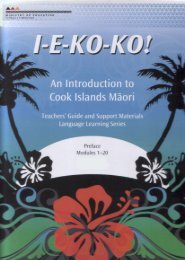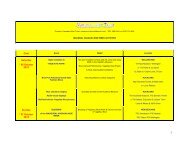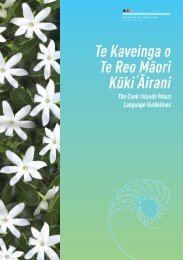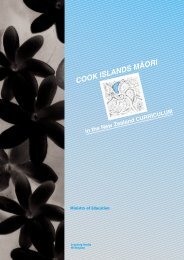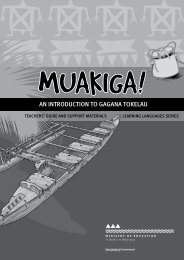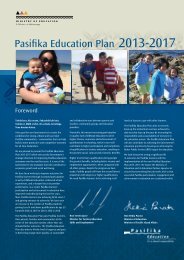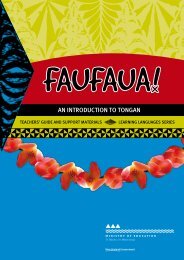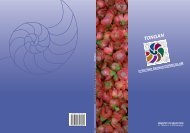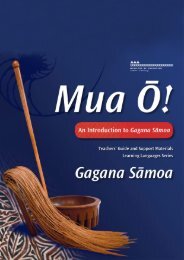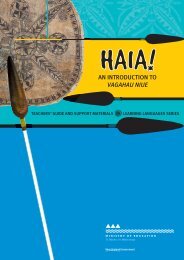Ta'iala mo le Gagana SÄmoa - Pasifika Education Community
Ta'iala mo le Gagana SÄmoa - Pasifika Education Community
Ta'iala mo le Gagana SÄmoa - Pasifika Education Community
You also want an ePaper? Increase the reach of your titles
YUMPU automatically turns print PDFs into web optimized ePapers that Google loves.
‘Aiseā e A‘oa‘o ai <strong>le</strong><strong>Gagana</strong> Sā<strong>mo</strong>a?Why Learn <strong>Gagana</strong> Sā<strong>mo</strong>a?‘O lau gagana, ‘o lou fa‘asinomagaYour language is your identity.New Zealand is an increasingly diverse and multicultural society situated in the South Pacific, and thecountry’s culture is underpinned by the bicultural partnership that is based on the Treaty of Waitangi.Learning gagana ma <strong>le</strong> aganu‘u fa‘asā<strong>mo</strong>a helps <strong>le</strong>arners to participate actively in New Zealand’sdiverse society and in the wider South Pacific, providing individual, social, and economic benefits.8Many peop<strong>le</strong> from Sā<strong>mo</strong>a have sett<strong>le</strong>d in New Zealand. Many children born in New Zealand are ofSa<strong>mo</strong>an heritage, and this population is steadily increasing. Included in this group are those peop<strong>le</strong>who have dual (or multip<strong>le</strong>) heritages. Learning gagana ma <strong>le</strong> aganu‘u fa‘asā<strong>mo</strong>a enab<strong>le</strong>s <strong>le</strong>arners whoare of Sa<strong>mo</strong>an heritage to affirm their sense of identity and belonging as they use and advance theirknow<strong>le</strong>dge of their language and culture. Opportunities to <strong>le</strong>arn and use gagana Sā<strong>mo</strong>a will enhancetheir achievement and enab<strong>le</strong> them to make connections to the wider community of speakers of thelanguage. Increasing the cultural and linguistic competence of these new speakers of gagana Sā<strong>mo</strong>awill enab<strong>le</strong> them to establish and maintain communication across the generations, which will help toensure that the history, culture, and traditions of Sā<strong>mo</strong>a are retained.Learners without kinship ties can also access gagana ma <strong>le</strong> aganu‘u fa‘asā<strong>mo</strong>a in places where teachingand <strong>le</strong>arning programmes are availab<strong>le</strong>. Participating in these programmes will increase these <strong>le</strong>arners’know<strong>le</strong>dge and experience of a language that is spoken in community settings and in workplaces inmany parts of New Zealand. This <strong>le</strong>arning will enab<strong>le</strong> them to build closer relationships with peop<strong>le</strong>in these communities.Learning another language extends <strong>le</strong>arners’ potential for <strong>le</strong>arning further languages and developsskills that are useful in a range of careers and employment situations. As <strong>le</strong>arners become increasinglybilingual or multilingual, they also develop their cognitive abilities and their understanding of thepower of language.Learning gagana ma <strong>le</strong> aganu‘u fa‘asā<strong>mo</strong>a enab<strong>le</strong>s students to encounter and explore new ways ofinteracting with others, to value their own language(s), and to think about the world and theirplace in it. The New Zealand Curriculum describes these processes in the following way:Learning a new language extends students’ linguistic and cultural understanding and their ability tointeract appropriately with other speakers. Interaction in a new language … introduces them to newways of thinking about, questioning, and interpreting the world and their place in it. Through suchinteraction, students acquire know<strong>le</strong>dge, skills, and attitudes that equip them for living in a world ofdiverse peop<strong>le</strong>s, languages, and cultures. As they <strong>mo</strong>ve between, and respond to, different languagesand different cultural practices, they are chal<strong>le</strong>nged to consider their own identities and assumptions.The New Zealand Curriculum, page 24<strong>Gagana</strong> Sā<strong>mo</strong>a ma <strong>le</strong> aganu‘u fa‘asā<strong>mo</strong>a are precious to those in the community of speakers and atreasure for all who wish to share in this know<strong>le</strong>dge and sense of belonging.



